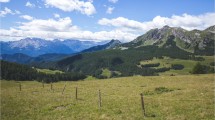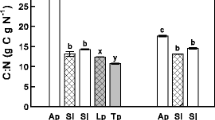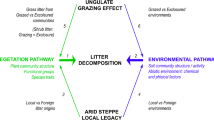Abstract
Direct and indirect biotic interactions may affect plant growth and development, but the magnitude of these effects may vary depending on environmental conditions. In grassland ecosystems, competition is a strong structuring force. Nonetheless, if hemiparasitic plant species are introduced the competition intensity caused by the dominant species may be affected. However, the outcome of these interactions may change between wet or dry periods. In order to study this, we performed a pot experiment with different densities of the dominant species Schedonorus arundinaceus (1, 2 or 4 individuals) under constantly moist or intermittently dry conditions. The different Schenodorus densities were crossed with presence or absence of hemiparasites (either Rhinanthus minor or R. alectorolophus). Additionally, pots remained with bare ground or received a grass litter layer (400 g m−2). We expected that indirect litter effects on vegetation (here Schedonorus or Rhinanthus) vary depending on soil moisture. We measured Schedonorus and Rhinanthus aboveground biomass and C stable isotope signature (δ13C) as response variables. Overall, Schedonorus attained similar biomass under moist conditions with Rhinanthus as in pots under dry conditions without Rhinanthus. Presence of Rhinanthus also increased δ13C in moist pots, indicating hemiparasite-induced water stress. Litter presence increased Schedonorus biomass and reduced δ13C, indicating improved water availability. Plants under dry conditions with litter showed similar biomass as under wet conditions without litter. Hemiparasites and litter had opposite effects: hemiparasites reduced Schedonorus biomass while litter presence facilitated grass growth. Contrary to our expectations, litter did not compensate Schedonorus biomass when Rhinanthus was present.



Similar content being viewed by others
References
Adams M, Grierson P (2001) Stable isotopes at natural abundance in terrestrial plant ecology and ecophysiology: an update. Plant Biol 3:299–310
Ameloot E, Verheyen K, Hermy M (2005) Meta-analysis of standing crop reduction by Rhinanthus spp. and its effect on vegetation structure. Folia Geobot 40:289–310
Atsatt P, Strong DR (1970) The population biology of annual grassland hemiparasites. I. The host environment. Evolution 24:278–291
Berg B (2000) Litter decomposition and organic matter turnover in northern forest soils. For Ecol Manag 133:13–22
Bergelson J (1990) Life after death: site pre-emption by the remains of Poa Annua. Ecology 71:2157–2165
Bu Z-J, Zheng X-X, Rydin H, Moore T, Ma J (2013) Facilitation vs. competition: does interspecific interaction affect drought responses in Sphagnum? Basic Appl Ecol 14:574–584
Bullock JM, Pywell RF (2005) Rhinanthus: a tool for restoring diverse grassland? Folia Geobot 40:273–288
Davies D, Graves J, Elias C, Williams P (1997) The impact of Rhinanthus spp. on sward productivity and composition: implications for the restoration of species-rich grasslands. Biol Conserv 82:87–93
Dawson TE, Mambelli S, Plamboeck AH, Templer PH, Tu KP (2002) Stable isotopes in plant ecology. Annu Rev Ecol Syst 33:507–559
Deutsch E, Bork E, Willms W (2010) Soil moisture and plant growth responses to litter and defoliation impacts in Parkland grasslands. Agric Ecosyst Environ 135:1–9
Eckstein RL, Donath TW (2005) Interactions between litter and water availability affect seedling emergence in four familial pairs of floodplain species. J Ecol 93:807–816
Facelli JM, Pickett STA (1991) Plant litter: its dynamics and effects on plant community structure. Bot Rev 57:1–32
Gibson D, Newman J (2001) Festuca arundinacea Schreber (F. elatior L. ssp. arundinacea (Schreber) Hackel). J Ecol 89:304–324
Gibson C, Watkinson A (1989) The host range and selectivity of a parasitic plant: Rhinanthus minor L. Oecologia 78:401–406
Hejcman M, Schellberg J, Pavlů V (2011) Competitive ability of Rhinanthus minor L. in relation to productivity in the Rengen Grassland Experiment. Plant Soil Environ 57:45–51
Hovstad KA, Ohlson M (2008) Physical and chemical effects of litter on plant establishment in semi-natural grasslands. Plant Ecol 196:251–260
Hovstad KA, Ohlson M (2009) Conspecific versus heterospecific litter effects on seedling establishment. Plant Ecol 204:33–42
Inderjit, Seastedt TR, Callaway RM, Pollock JL, Kaur J (2008) Allelopathy and plant invasions: traditional, congeneric, and bio-geographical approaches. Biol Invasions 10:875–890
Jensen K, Gutekunst K (2003) Effects of litter on establishment of grassland plant species: the role of seed size and successional status. Basic Appl Ecol 4:579–587
Jiang F, Timergalina L, Kudoyarova G, Jeschke WD, Hartung W (2007) Growth and development of the facultative root hemiparasite Rhinanthus minor after removal of its host. Funct Plant Biol 34:237–245
Jiang F, Jeschke WD, Hartung W, Cameron DD (2010) Interactions between Rhinanthus minor and its hosts: a review of water, mineral nutrient and hormone flows and exchanges in the hemiparasitic association. Folia Geobot 45:369–385
Knapp AK, Fay PA, Blair JM, Collins SL, Smith MD, Carlisle JD, Harper CW, Danner BT, Lett MS, McCarron JK (2002) Rainfall variability, carbon cycling, and plant species diversity in a mesic grassland. Science 298:2202–2205
Legendre P, Legendre L (1998) Numerical ecology. Elsevier Science BV, Amsterdam
Levine JM (1999) Indirect facilitation: evidence and predictions from a riparian community. Ecology 80:1762–1769
Lortie CJ, Brooker RW, Choler P, Kikvidze Z, Michalet R, Pugnaire FI, Callaway RM (2004) Rethinking plant community theory. Oikos 107:433–438
Loydi A, Eckstein RL, Otte A, Donath TW (2013) Effects of litter on seedling establishment in natural and semi-natural grasslands: a meta-analysis. J Ecol 101:454–464
Loydi A, Lohse K, Otte A, Donath TW, Eckstein RL (2014) Distribution and effects of tree leaf litter on vegetation composition and biomass in a forest-grassland ecotone. J Plant Ecol 7:264–275
Loydi A, Donath TW, Eckstein RL, Otte A (2015a) Non-native species litter reduces germination and growth of resident forbs and grasses: allelopathic, osmotic or mechanical effects? Biol Invasions 17:581–595
Loydi A, Donath TW, Otte A, Eckstein RL (2015b) Negative and positive interactions among plants: effect of competitors and litter on seedling emergence and growth of forest and grassland species. Plant Biol 17:667–675
Moreno-Gutiérrez C, Dawson TE, Nicolás E, Querejeta JI (2012) Isotopes reveal contrasting water use strategies among coexisting plant species in a Mediterranean ecosystem. New Phytol 196:489–496
Morin PJ (2009) Community ecology. Wiley, New York
Mudrák O, Mládek J, Blazek P, Leps J, Dolezal J, Nekvapilová E, Tesitel J (2014) Establishment of hemiparasitic Rhinanthus spp. in grassland restoration: lessons learned from sowing experiments. Appl Veg Sci 17:274–287
Murphy BP, Bowman DM (2009) The carbon and nitrogen isotope composition of Australian grasses in relation to climate. Funct Ecol 23:1040–1049
Myers RJK, van Noordwijk M, Vityakon P (1997) Synchrony of nutrient release and plant demand: plant litter quality, soil environment and farmer management options. In: Cadisch G, Guiller K (eds) Driven by nature: plant litter quality and decomposition. CAB International, Wallingford, pp 215–229
Napier JD, Mordecai EA, Heckman RW (2016) The role of drought-and disturbance-mediated competition in shaping community responses to varied environments. Oecologia 181:621–632
Pärtel M, Bruun HH, Sammul M (2005) Biodiversity in temperate European grasslands: origin and conservation. In: 13th international occasional symposium of the European Grassland Federation. Integrating efficient grassland farming and biodiversity: proceedings of the 13th international occasional symposium of the European Grassland Federation, pp 1–14
Phoenix GK, Press MC (2005) Linking physiological traits to impacts on community structure and function: the role of root hemiparasitic Orobanchaceae (ex-Scrophulariaceae). J Ecol 93:67–78
Press MC, Phoenix GK (2005) Impacts of parasitic plants on natural communities. New Phytol 166:737–751
Pywell RF, Bullock JM, Walker KJ, Coulson SJ, Gregory SJ, Stevenson MJ (2004) Facilitating grassland diversification using the hemiparasitic plant Rhinanthus minor. J Appl Ecol 41:880–887
Resco de Dios V, Weltzin JF, Sun W, Huxman TE, Williams DG (2014) Transitions from grassland to savanna under drought through passive facilitation by grasses. J Veg Sci 25:937–946
Ruprecht E, Szabo A (2012) Grass litter is a natural seed trap in long-term undisturbed grassland. J Veg Sci 23:495–504
Ruprecht E, Enyedi MZ, Eckstein RL, Donath TW (2010a) Restorative removal of plant litter and vegetation 40 years after abandonment enhances re-emergence of steppe grassland vegetation. Biol Conserv 143:449–456
Ruprecht E, Józsa J, Ölvedi TB, Simon J (2010b) Differential effects of several “litter” types on the germination of dry grassland species. J Veg Sci 21:1069–1081
Schmiede R, Ruprecht E, Eckstein RL, Otte A, Donath TW (2013) Establishment of rare flood meadow species by plant material transfer: experimental tests of threshold amounts and the effect of sowing position. Biol Conserv 159:222–229
Spasojevic MJ, Suding KN (2011) Contrasting effects of hemiparasites on ecosystem processes: can positive litter effects offset the negative effects of parasitism? Oecologia 165:193–200
Török P, Miglécz T, Valkó O, Kelemen A, Tóth K, Lengyel S, Tóthmérész B (2012) Fast restoration of grassland vegetation by a combination of seed mixture sowing and low-diversity hay transfer. Ecol Eng 44:133–138
Violle C, Richarte J, Navas M-L (2006) Effects of litter and standing biomass on growth and reproduction of two annual species in a Mediterranean old-field. J Ecol 94:196–205
Westbury DB (2004) Rhinanthus minor L. J Ecol 92:906–9027
Wolfe A, Randle C, Liu L, Steiner K (2005) Phylogeny and biogeography of Orobanchaceae. Folia Geobot 40:115–134
Yahdjian L, Sala OE (2006) Vegetation structure constrains primary production response to water availability in the Patagonian steppe. Ecology 87:952–962
Acknowledgements
This work was partly funded by the Alexander von Humboldt Foundation by means of a Georg-Forster-postdoctoral fellowship (A. L.). We thank Lena Kretz and Joseph Scholz-vom Hofe (both Giessen University) for invaluable help during the experiment.
Author information
Authors and Affiliations
Corresponding author
Additional information
Communicated by Marjan Jongen.
Electronic supplementary material
Below is the link to the electronic supplementary material.
Rights and permissions
About this article
Cite this article
Loydi, A., Eckstein, R.L., Gebauer, T. et al. Opposite effects of litter and hemiparasites on a dominant grass under different water regimes and competition levels. Plant Ecol 219, 133–144 (2018). https://doi.org/10.1007/s11258-017-0783-1
Received:
Accepted:
Published:
Issue Date:
DOI: https://doi.org/10.1007/s11258-017-0783-1




